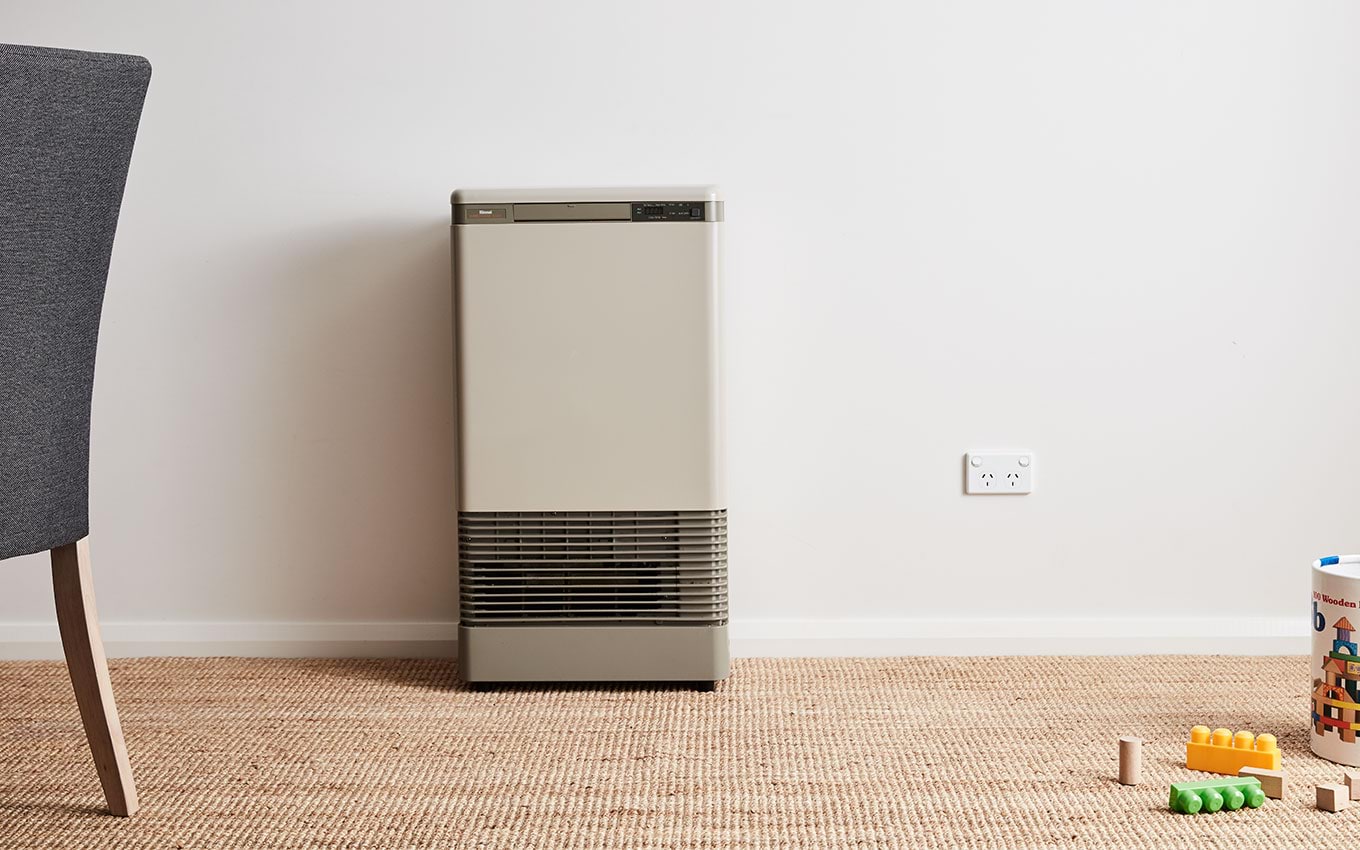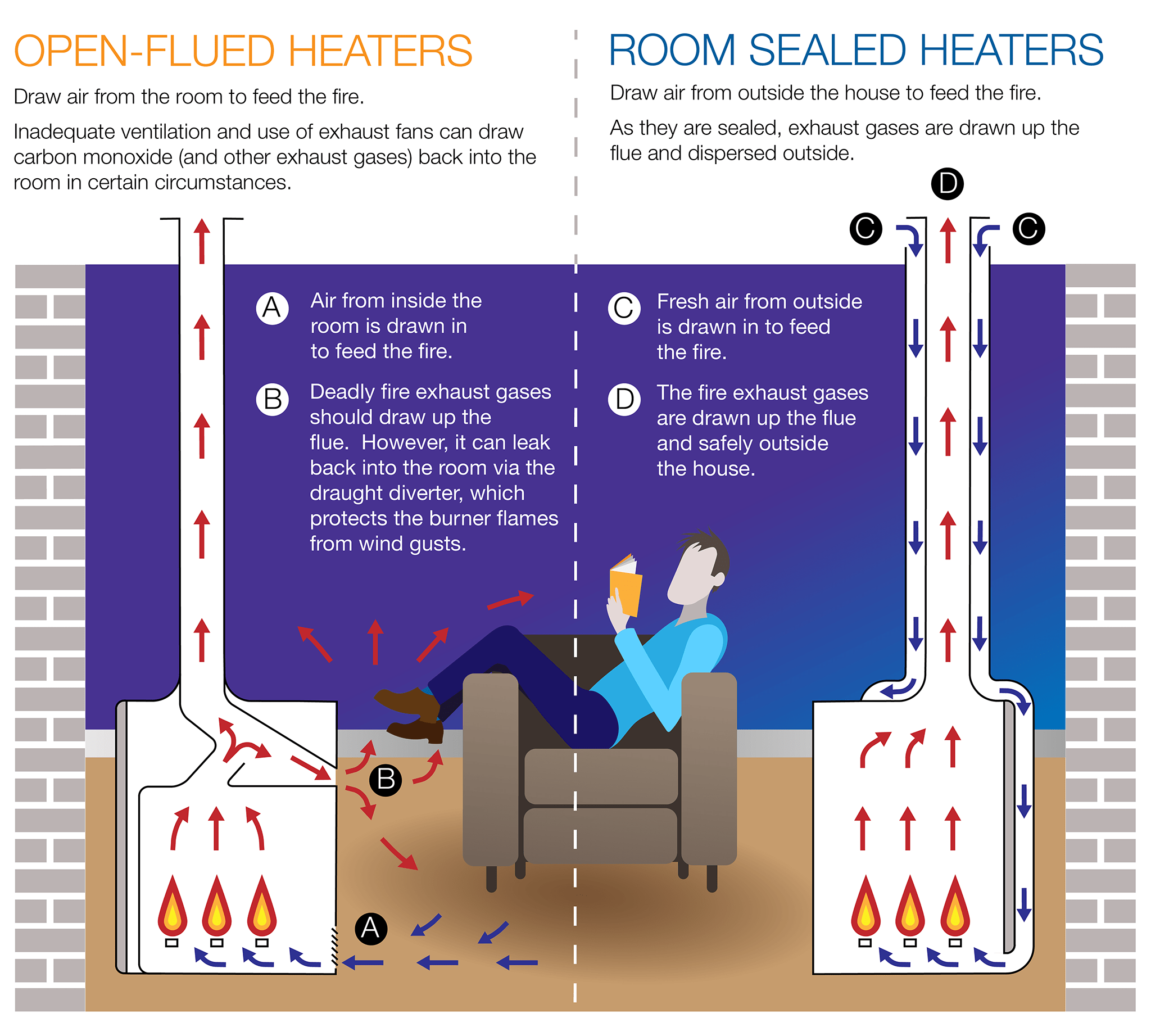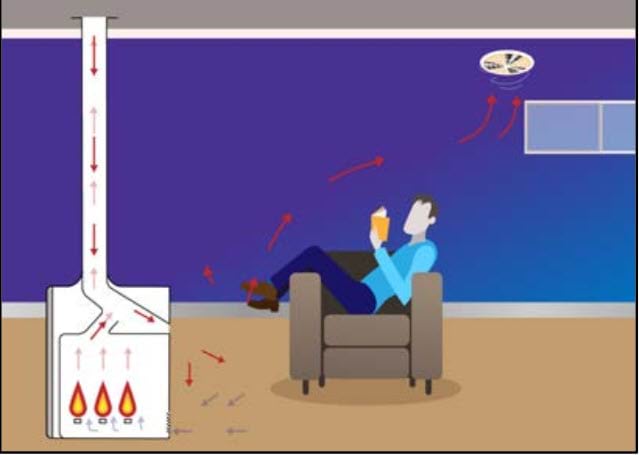Home heating and gas safety
This winter entire families will be staying at home for longer periods. We want you to stay safe while staying warm.
Gas heating is generally a safe way to keep your house warm. But if you don’t use your heater properly, or your house does not have enough fresh air, your gas heater can spill carbon monoxide and become dangerous.
Carbon monoxide – what are the risks?
Carbon monoxide (CO) is a gas you can’t see or smell.
When it spills from your gas heater, it can make you very sick or even kill you and your family.
Any gas heater can spill CO – including old and new heaters, central heating units, space heaters, wall furnaces and decorative log fires.
To avoid the risk, we recommend that all gas heaters are serviced at least every two years by a qualified gasfitter. A qualified gasfitter will inspect your heater and check its installation, including testing for CO leakage.
Use your gas heater safely
- Have your heater serviced at least once every two years by a qualified gasfitter – you can check their licence online
- Check if your heater is affected by a safety alert
- Ensure adequate ventilation in your home – check your permanent ventilation is clear, and leave a window open if necessary, especially if your heater is open-flued
- Don’t use kitchen rangehoods or bathroom exhaust fans at the same time as your heater. It can create a negative pressure environment, drawing carbon monoxide into living spaces. Read more about Negative pressure environments
- Don’t leave your gas heater on overnight, or for extended periods.
- Check for changes in how your gas heater operates. For example if the flame changes from its usual colour. If there is any change, you must get a qualified gasfitter to inspect your gas heater and check it for CO leakage. If your heater is old, or hasn’t been serviced for several years, consider replacing it.
- Install a carbon monoxide alarm as a back-up measure.
- Know the symptoms of CO poisoning and act quickly if you notice them.
Don’ts
- Do not bring outdoor gas appliances inside your home, caravan, car or tent.
- Do not attempt to fix your gas heater yourself – gas work is not a DIY project (you must call a qualified gasfitter).
- Do not use gas appliances for purposes other than their intended use e.g. do not use a gas cooker, cooktop or oven as your heater.
Better Health has a Cold Weather Fact Sheet with tips on keeping warm and safe during the winter months.
Finding a licensed gasfitter
Gasfitters have different types of licences depending on the work they are qualified to do.
When searching for a gasfitter, you will need to check their qualifications and areas of expertise. Contact them and ask if they are licensed for the service required. When they attend the site, ask to check their licence card and the registered classes listed on the back of the card.
Type A gasfitters
There are two different types of gas appliances – Type A and Type B appliances.
Type A appliances include domestic and light commercial type appliances such cookers, space heaters, central heaters, water heaters, catering equipment and leisure appliances. So, when looking to service and repair your gas heater, be sure it’s done by a licensed Type A gasfitter.
Look out for the licence/s below when choosing a gasfitter to carry out the work. Check that they are qualified to carry out Type A appliance servicing.
Carbon monoxide (CO) alarms
If you are considering purchasing one or more carbon monoxide alarms, remember to:
- select alarms that meet US or EU carbon monoxide standards, including recommendations for use and installation.
- On the alarm it will indicate that it complies with one of the following standards:
- UL2034 (US)
- EN50291 (EU)
- select alarms that provide visual and audible alarms indicating when the electrochemical sensor or battery has expired.
While these alarms may provide an indication of the presence of CO, their effectiveness is limited to the location where they are installed, as CO levels elsewhere in the room may vary.
Installation
CO alarms can be purchased at your local hardware store.
- Follow the manufacturer’s installation instructions. This should detail where the alarm is to be located.
- Regularly check and change the battery as advised by the manufacturer.
- Hard-wired alarms must be installed by a licensed electrician.
Safety advice – open-flued heaters
Open-flued heaters can spill carbon monoxide more easily than other types of heaters, making them more dangerous.
Check if a safety alert has been issued for your heater and follow the advice for getting it tested for CO.
Learn more about open-flued heaters and air flow below.
Safety alerts
Energy Safe has released safety alerts for the following gas heaters:
- Vulcan/Pyrox Heritage
- Cannon Fitzroy/Canterbury
- Regency i31 / Regency F38 and FG38
- Nectre 2000
- Real Flame Pyrotech.
People with these gas heaters in their homes need to contact the supplier and get them checked by a qualified gasfitter immediately.
New safety standards for gas space heaters
Victorians should consider new safety Standards before purchasing an open-flued gas space heater. The new Australian Standards require open-flued gas space heaters to shut down if carbon monoxide or other potentially lethal gasses leak into living spaces.
Background
The new standard came about after a recommendation from the Coroner after her inquiry into the 2017 death of Sonia Sofianopolous. Ms Sofianopolous' death was connected to carbon monoxide leakage from her open-flued gas space heater. One of the key causes of the leakage was negative pressure, where exhaust gases are drawn out of the heater by extraction fans (such as a kitchen rangehood or bathroom fan) in well-insulated houses with little ventilation.
The new Standard requires that open-flued gas space heaters shut down if there is spillage of combustion products (including carbon monoxide). New heaters that meet the standard will shut down automatically if they spill combustion products for more than 15 minutes. Once the appliance has shut down a gasfitter is required to make the installation safe and to reset the appliance.
Open-flued gas space heaters that currently meet the Standard
- Braemar Ecostar Power Flue Wall Furnace (certification no. AGA 8905)
- Archer Induced Draught Decorative Gas Log Effect Space Heater Models: FS100, FSP100, FSC100, IS100 & IS200 (certification no. AGA 5446)
- Archer 36″ Fireplace IS900 Series Models (certification no. AGA 7978)
- Archer Models IS1200 and IS1500 (certification no. GMK10519)
- Archer IS700 Induced draught decorative log effect space heater (certification no. SAI-400286).
When purchasing a new open-flued gas space heater, ask the supplier to provide the certification number and confirm that the appliance complies with the new safety standards.
Additional recommendations
Energy Safe Victoria also recommends room sealed gas space heaters, which draw their air for combustion from the outside atmosphere and therefore are not affected by a lack of building ventilation and the extraction fans.
If you have an open-flued gas space heater that does not meet the new Standards, make sure:
- you have your heater serviced by a qualified gasfitter at least once every two years (servicing ensures your heater will run safely and efficiently);
- there is adequate air flow in your home,
- you avoid running kitchen and bathroom extraction fans at the same time as the heater,
- A carbon monoxide alarm will help but should never be a substitute for regular servicing.
More information
Check the certification details of an open-flued gas space heater on the Gas Technical Regulators Committee (GTRC) website.
Open-flued gas space heaters
Energy Safe Victoria has prohibited the sale of old, unsafe open-flued gas space heaters. ‘Unsafe’ refers to heaters that don’t have safety shutdown features. This also includes second-hand heaters.
The prohibition takes effect 1 August 2022.
What are the safety concerns?
It’s possible for open-flued gas space heaters to spill carbon monoxide in a negative pressure environment.
Negative pressure can occur when a home isn’t ventilated enough and an exhaust fan is on. For example, when operating a:
- kitchen range hood
- bathroom fan
- roof-mounted exhaust fan.
This can cause external openings such as flues to draw air into the home. That means dangerous gasses such as carbon monoxide can be drawn into living spaces.
A safe open-flued gas space heater will shut down if this occurs.
For more information, view the fact sheet – what is negative pressure?:
About carbon monoxide
Carbon monoxide (CO) is a poisonous, colourless and odourless gas. CO interferes with the blood’s ability to carry oxygen. This can cause serious health issues and even be fatal.
Maintenance and correct ventilation will ensure gas appliances produce minimal CO.
High CO levels can occur under one or more of the following conditions:
- An appliance is faulty or not maintained.
- A flue is partially or totally blocked.
- An appliance is installed in an area that does not have adequate ventilation.
Flues and ventilation
Adequate ventilation and proper flueing are essential for the safe and efficient operation of gas appliances.
If you have an open flue heater, let fresh air flow through the room when the heater is on.
Open-flued heaters use air from inside the house – the same air that you breathe. The heater pulls the air through an opening, to feed a gas flame. This creates CO and other dangerous gases that can spill back into the room, via the opening, and make you very sick or even kill you.
To find out if your heater is open-flued, call the supplier or ask a qualified gasfitter next time you have your heater serviced.
Open-flued heaters
Following recent investigations, Enegy Safe believes that open-flued technology is incompatible with newer better sealed, energy efficient homes.
To identify whether your heater is ‘open-flued’, contact the manufacturer or check with your local gasfitter.
- Let some fresh air into your home when the heater is in use
- Have your heater serviced at least once every two years, including an inspection of the flue
- Keep plants and animal nests away from the outdoor end of the flue – this can block the flue and push CO back into the house
- Consider replacing your heater with a room-sealed heater or split system
- Never leave your heater on overnight; you will not be able to tell if it starts spilling CO
- Act quickly if you notice the symptoms of CO poisoning.
Read our FAQs to learn more.
Flueless heaters
Flueless heaters can be extremely dangerous. CO and other deadly gases spill directly into your home and mix with the air you breathe.
Ensure a room is adequately ventilated when an unflued appliance is being used. Unflued gas heaters consume air and release combustion products into the room and can make the room stuffy if there is inadequate ventilation.
There are restrictions on the installation of flueless heaters operating on Natural Gas in Victoria. Consult with your licensed gasfitter before considering purchasing or installing.
This restriction also applies to new and second-hand flueless heaters imported from interstate and overseas. Cabinet heaters (which are mobile heaters containing an LP Gas cylinder) are not permitted.
Negative pressure environment
Negative pressure can occur when there isn’t enough ventilation in the home and an exhaust fan is operating. Essentially, it has the effect of drawing air from any external opening in a house, including gas appliance flues and chimneys. This creates a problem with the operation of an open-flued gas heater, and particularly a faulty one – because it means that dangerous gasses, such as carbon monoxide (CO) can be drawn into living spaces via the gas appliance flue or chimney.
Simple steps you can take to resolve negative pressure
Victorian winters can be very cold, so it’s important to keep warm. If you have an open-flued gas heater there are some simple steps you can take that will keep you and your loved ones safe:
- Get your gas heater serviced once every two years
To ensure your heater runs safely and efficiently, and includes a check for negative pressure by your gasfitter. - Don’t operate exhaust fans at the same time as your heater
Your rangehood, toilet or bathroom fan can create a ‘negative pressure’ effect, drawing carbon monoxide into living areas. - Ensure you have adequate ventilation
While it’s not necessary to have windows and doors wide open on a freezing cold day, ventilation is important to ensure carbon monoxide isn’t drawn into a living space. - Don’t leave your gas heater on all night
Don’t leave the heater on for extended periods or when you don’t need it. - Consider installing back-up measures such as a carbon monoxide alarm
Carbon monoxide alarms can be a useful back-up precaution, but should not be considered a substitute for the proper installation and maintenance of gas heating appliances. Further information is available below. - Never use your outdoor heating appliances indoors
Outdoor heaters, such as patio heaters, barbecues, coal heaters and fire pits release carbon monoxide into the surrounding atmosphere. Carbon monoxide is lighter than air and can disperse more readily outdoors, but can be fatal if used indoors.
What is negative pressure?
The information sheet and video aim to help you understand
- what a negative pressure environment is
- its effect on open flue gas heaters
- how to test for it and
- how to mitigate it.
A negative pressure environment - diagram
See also Negative pressure environments
Date: 21/12/2025 19:11
Controlled document
The currency and accuracy of this document cannot be guaranteed once printed or saved to a storage device. If in doubt, please check the ESV website for the current version.
Reviewed



